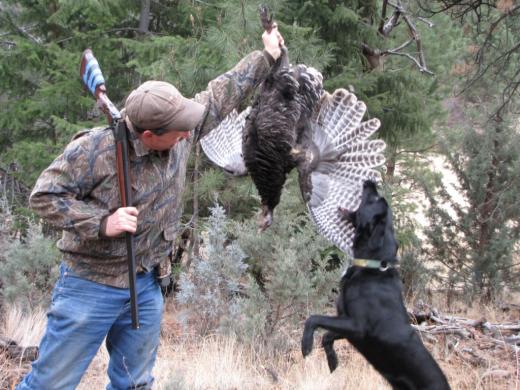The Feather Dance
The whistling crescendo of rushing air was not only startling, it was almost unnerving. Like an eerie formation of B-17s, they loomed into sight, straight on over the ponderosas. Twelve o’clock high, as they say. No time to gawk or even take cover; I needed to make good on my promise.
We who live with gun dogs stumble through life up to our lanyards in hopeless debt. I’m not talking about the inescapable vet and feed bills; those obligations can be paid off. But how do you repay a companion who happily produces 110 percent every day of her life, often in the most gawdawful weather or obscenely vertical terrain—in a quest just to please you?
Realistically, you cannot. But you have to try.
For the first 10 years of her life I never found the bottom in Grand River Gina Bella (simply “Bella,” during quiet times). She worked and retrieved my now-grown son’s first bird (a quail) as well as his hundredth—and well over a thousand for me.
Like a sleek, black auger, she bore holes through thistle, rose and willow thickets to boost bashful birds or chase down cripples. She delivered to hand chukars and blue grouse that had spiraled hopelessly to the bottoms of the West’s deepest canyons. She asked for nothing in return and was content with simply carrying one of the birds back to the pickup as her only reward. She deserved so much more.
Introductions of wild turkeys had begun to flourish in eastern Oregon years earlier, and whenever we’d see some during our travels, Gina’s hard focus, soft whine and excited tremble told me she yearned for an encounter with our country’s biggest upland bird.
“One of these days, Bella,” I’d vow, “I’m going to shoot one of those things out of the air for you and let you retrieve it.”
Eventually, the adoption of a controlled fall turkey season made that notion seem not so farfetched. Unlike the spring gobbler season, not only could fall turkeys be hunted with dogs, but hens could be taken as well, making sex determination less of an issue.
So as I slid the safety ahead on my twenty, it appeared I’d finally have the opportunity to fulfill my promise. Could I pull it off?
Others had said shooting turkeys on the wing is damn near impossible due their size and heavy plumage. But size or thick feathers shouldn’t matter; if I can hit a smaller, faster quail, I reasoned, I could put just as many bb’s on a turkey’s head.
Nearly straight over me and tree-top high, I pushed my eyes from the bulk of the squadron to the lead bird, then ahead to its neck and head. When its beak came into sharp focus I yanked and let the magic happen. In what seemed less than a second, Gina, who had put the birds up far up the ridge ahead of me, streaked past and was on her prize even before it came completely to rest.
The retrieve was a struggle, but she pulled it off. Thank God it was a short one and involved a young hen. She wouldn’t be able to pack it back for me, but we did do the feather dance, where we frolicked and crazily played with the bird for a bit (nothing maintains the birdiness in a dog—even one 12 years old—like the feather dance). I hadn’t seen Gina so juiced in years.
Gina Bella left us late in her 14th year. Now, as she rests near the deck where she’d lay during her later years and watch out over her mountain. I rest a bit easier knowing one of her all-time ambitions had been fulfilled. After sharing a lifetime of love, respect and wild country with that little girl, it was the least I could do.
Mark Bagett is the Oregon coordinator for TU’s Sportsman’s Conservation Project, and lives with his wife, Brenda, on their mountain property outside Canyon City in the eastern portion of the state. The couple is anxiously awaiting the arrival of their next Grand River Labrador pup, hopefully sometime this winter.

